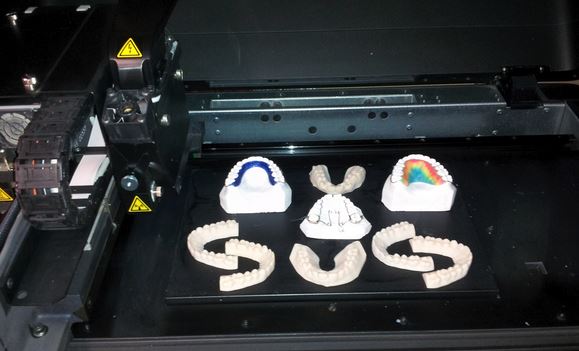Instead of gagging on the clay-like material orthodontists often use to make impressions of their teeth, patients at Smile Frederick Orthodontics bite down on a camera that scans and photographs the inside of their mouths.
Orthodontist Jim Lee uploads those images to the Internet-based cloud storage site Dropbox, where John Bifareti, owner of Gaithersburg-based Bayridge Lab, downloads them. Bifareti uses a 3-D printer to rapidly produce models of a patient’s teeth, and then tailors expanders, retainers and other orthodontic appliances to their specifications.
This digital method, which Lee has been using for the past year, is faster and more accurate than the traditional one, he said.
Before 3-D printers, orthodontists had to mix a material called alginate, which patients had to keep in their mouth for about 3 minutes until it hardened. A patient might have to come in a few times to make these alginate impressions, which staff would physically package and ship to Bayridge Lab. And sometimes alginate models became distorted in the trip from the office to the lab, Lee said.
Now, Bifareti can access the images instantly, and can print a model the same day. Bayridge Lab prints about 15 models for Smile Frederick each week, Lee estimated.
A series of teeth molds, printed at Gaithersburg-based Bayridge Lab using a Stratsys Objet30 OrthoDesk 3-D printer. (Courtesy of John Bifareti) There is an added cost, Lee said — but it’s one he and his staff are willing to pay. Bayridge Lab charges about $20 for a 3-D printed model, covering the cost of the plastic material, while alginate models are about $4. . (Bifareti noted that the price for models sometimes varies depending on the amount of plastic he needs to print them — a patient with larger or taller teeth might cost more.)
“We do save a lot of cost, indirectly, by not needing more storage space,” Lee said. Traditionally, orthodontic practices kept a special room to keep plaster models for patients, he said, but Smile Frederick Orthodontics — which opened in August of 2013 — has not needed one so far, he said.
And not all orthodontists are trained to use a digital model — so it may not work for each practice, he said. Smile Frederick opened in August of last year, and most of its staff has worked with digital models before, he said.
“Doctors that have been trained and used to the [plaster] models prefer them because you can hold it up and orient it, and you can’t digitally. It takes a little bit of technical knowledge and flexibility on the doctors’ side to be able to get used to it.”
Of Bifareti’s customers, only a handful have transitioned to a fully digital process, he said. While he considers his 3-D printer a worthwhile investment (he uses a Stratasys OrthoDesk, which retails for about $31,000 including printing material and installation), he plans to also buy a scanner to digitize the alginate models that most of his customers still send him.
This article was found on WashingtonPost.com

